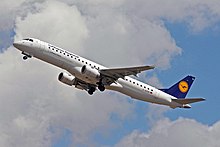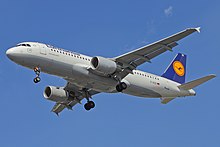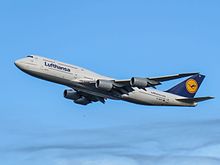Short-haul and long-haul
A flight's length can also be described using the aviation term of "Flight Haul Type", such as "short-haul" or "long-haul". Flight haul types can be defined using either flight distance or flight time.[4]
Time-based definitions
| Short-haul | Medium-haul | Long-haul | Ultra-long-haul | |
|---|---|---|---|---|
| ICAO[5][6] | < 8 hours | 8–16 hours | > 16 hours | |
| IATA[4][7][8][9] | < 3 hours | 3–6 hours | 6–16 hours | > 16 hours |
| CAPA [10] | < 6 hours | 6–16 hours | > 16 hours |
Distance-based definitions



David W. Wragg classifies air services as medium-haul being between 1,600–4,000 km; 900–2,200 nmi; short-haul asbeing shorter and long-haul as being longer.[11] David Crocker defines short-haul flights as shorter than 1,000 km (540 nmi),[12]: 208 and long-haul as the opposite.[12]: 140
Asia & Australia
- Hong Kong International Airport considers destinations in North and South Americas, Europe, the Middle East, Africa, Southwest Pacific and the Indian Subcontinent long-haul and all others are short-haul.[13]
- Japan Air Lines defines routes to Europe and North America as long-haul and all other flights as short-haul.[14]
- Qatar Airways defines all flights from Qatar to the Americas, Australia, and New Zealand as Ultra-long-haul, and all other flights as medium or long-haul.[15]
- Virgin Australia defines domestic flights as within Australia, short-haul as those to South East Asia/Pacific and long-haul as those to Abu Dhabi or Los Angeles.[16]
Europe
- The European Union defines any passenger flight between city pairs separated by a great circle distance between 1,500 and 3,500 km (800 and 1,900 nmi) to be medium-haul, below as short-haul, and above as long-haul routes.[17]
- Eurocontrol defines "very short-haul" flights as being less than 500 km (270 nmi), short-haul flights being between 500 and 1,500 km, medium-haul flights being between 1,500 and 4,000 km (800 and 2,200 nmi), and long-haul flights as longer than that.[18]
- The Association of European Airlines defined Long-haul as flights to Americas, sub-Saharan Africa, Asia, Australasia and medium-haul as flights to North Africa and Middle East.[19]
- The now defunct airline Air Berlin defined short- and medium-haul as flights to Europe/North Africa and long-haul as those to the rest of the world.[20]
- Air France defines short-haul as domestic, medium-haul as within Europe/North Africa and long haul as the rest of the world.[21]
North America
- American Airlines defines short-/medium-haul flights as being less than 3,000 mi (2,600 nmi; 4,800 km) and long-haul as either being more than 3000 miles or being the New York–Los Angeles and New York–San Francisco routes.[22]
- United Airlines defines short-haul flights as being less than 700 mi (600 nmi; 1,100 km)[23] and long-haul flights as being greater than 3,000 mi (2,600 nmi; 4,800 km).[24]
Aircraft-based definitions
Flight Haul Type terms are sometimes used when referring to commercial aircraft. Some commercial carriers choose to refer to their aircraft using flight haul type terms, for example:
- Delta Air Lines referred to its Boeing 717, MD-88 and MD-90 as short-haul domestic aircraft; Boeing 757, Boeing 737, Airbus A319 and A321 as long-haul domestic; and its transoceanic Boeing 757, 767, 777 and Airbus A330 as long-haul.[25]
- Lufthansa classifies its fleet as: long-haul for wide-body aircraft such as the Airbus A330/Airbus A340, Airbus A350, Airbus A380, Boeing 747, and Boeing 787 Dreamliner; medium-haul for narrow-body aircraft like the Airbus A320 and 737 families; and short-haul for regional jets like the Embraer E-Jets and the Bombardier CRJ-900.[26]
- TUI Airways refers to their Boeing 737 as a short and mid-haul airliner and the Boeing 767 and 787 as long haul.[27]
While they are capable of flying further, long-haul capable wide-bodies are often used on shorter trips. In 2017 - 40% of A350 routes were shorter than 2,000 nmi (2,300 mi; 3,700 km), 50% of A380 flights fell within 2,000–4,000 nmi (2,300–4,600 mi; 3,700–7,400 km), 70% of 777-200ER routes were shorter than 4,000 nmi (4,600 mi; 7,400 km), 80% of 787-9s routes were shorter than 5,000 nmi (5,800 mi; 9,300 km), 70% of 777-200LRs flights were shorter than 6,000 nmi (6,900 mi; 11,000 km).[28]
